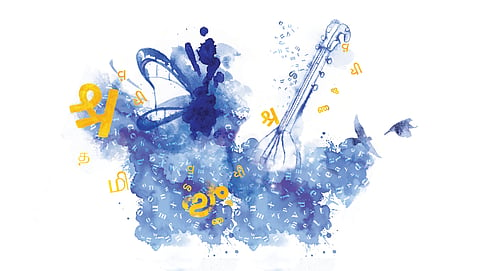Nature writes back: Feelings die with language
Today, 197 mature languages of our country are on the verge of extinction. Ever since our education policy started prioritising one or at most two languages, our other spoken languages have become marginalised and their numbers have started to decline. These languages are not inferior in any way. The irony is that our modern society kept these languages insulated from our education, judicial and political systems. That the attitude of the government is biased can be seen from the fact that 57 languages were included as dialects under the Hindi language. These 57 languages were not given language status. All of these are rich languages like Awadhi, Braj or Rajasthani. The government does not even count the languages spoken by less than 10,000 people.
Most of our languages are part of oral literature. These are a social document that carry every section of society along with them. The entire community listens, sings and ponders over them. Oral literature has the tendency to flow like a stream which is something that written literature does not possess. It does not consider prose, poetry, dance or song as separate units but as a complete, collective unit, and then tries to connect it with society, its thinking/ideology, its experiences and its world view. As a consequence of its social inclusivity, oral literature fully reflects every part of life—every turn, moment of happiness and sorrow. We have songs that connect every stage in a person’s life—from the birth of a child to the death of someone old. We have songs and poems for every moment of happiness and sadness. This is what the written literature does not possess. This is why we can never let oral literature die. Since our mother tongue is the result of our thoughts, feelings, experiences, and world view, we should impart education in our mother tongue in schools. The first stage of education of children should be in their mother tongue so that they can learn to express themselves. According to the 2011 census, there are 1,369 mother tongues in the country and of these, 800 exist in the oral form. People who speak these languages are multilingual or speak more than one dialect, except the speakers who live in remote forests or mountains.
Institutions around the world have their own indexes for maturity of language, all of them prepared in different ways. For example UNESCO and Ethnologue have their own index. We linguists have made many changes in both the indexes in the context of Indian languages. Actually, the index prepared by these institutions depends on whether the language is written or not.
Very few people know that there are 800 languages in India that have never been written. They have been going on like this for thousands of years. These languages are very mature. It is a belief generally held that a language which does not have a script is weak. This is a misconception. Many languages have survived for a long time because they are being passed on from one generation to another. This brings/imparts new dimensions to the languages. If we take the point of view of UNESCO or Ethnologue, then most of these languages are going to die. That is why our standards need to be different. Why should we ape the West? We cannot ignore oral literature.
Language touches every part of our life. When language dies, our multilingualism dies with it. In fact, the entire society withers away. All kinds of knowledge about the environment is lost. There is a deep and unbreakable relationship be-tween environment and language. The Great Andamanese people had many words for smells. All of those smells had different names. We found out the names of 17-18 such smells. Now all knowledge about these smells has been lost. Similarly, there are four words for the seashore alone. There are different words for the sandy part, the wet part, the ankle-deep water and the knee-deep water. The beach has a different word for it. I had found 97 words for birds in the Great Andamanese language. An Andamanese boy introduced me to the birds and told me their names.
Now the Great Andamanese people have no knowledge of these names and would not be able to identify the birds. This is why I say that language remains connected to our feelings. I will provide two examples of this. In the Mayan language, spoken in South America, there were nine words for butterflies of the colour blue. With the advent of the Spanish language, the number of words was reduced to three. In this way, the expressive potential of the next generation also got reduced to three colours. In this way, their perception of colours ended.
Similarly, in Odisha’s Koraput town, 1,800 varieties of rice were grown prior to the Green Revolution, but now their names have disappeared. Only three-four varieties of rice are left. Along with the names of those varieties, the names of their respective tastes have also ended. People tell us that the original taste has become elusive now. They do not even remember the words for those tastes.
This is what happens when we eliminate diversity and bring uniformity forcefully. This is why we can say that language captures our feelings. With the demise of a language, the feelings also die.
(Anvita Abbi is an Indian linguist and scholar of minority languages)
This series explores the most pressing environmental issues through the prism of literature
This article was originally published in the May 16-31, 2025 print edition of Down To Earth


